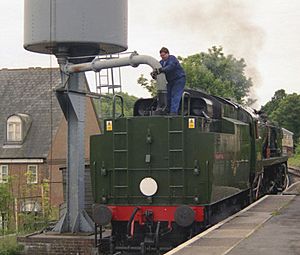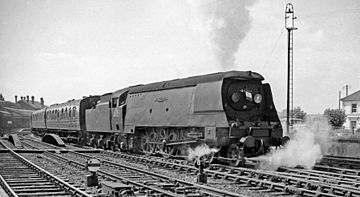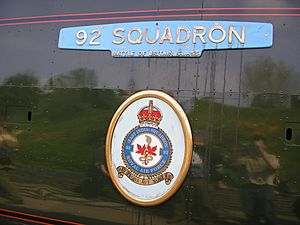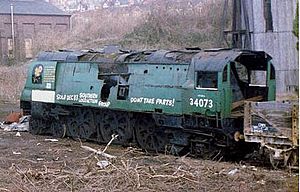SR West Country and Battle of Britain classes facts for kids
Quick facts for kids SR unrebuilt West Country/Battle of Britain classes |
|
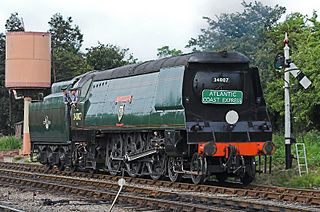 |
|
| Unrebuilt West Country class No. 34007 Wadebridge, as preserved, in British Railways lined green express passenger livery | |
| Power type | Steam |
|---|---|
| Designer | Oliver Bulleid |
| Builder |
|
| Build date | 1945–1951 |
| Total production | 110 |
| Configuration | 4-6-2 (Pacific) |
| Gauge | 4 ft 8 1⁄2 in (1,435 mm) standard gauge |
| Leading wheel diameter | 3 ft 1 in (0.940 m) |
| Driver diameter | 6 ft 2 in (1.880 m) |
| Trailing wheel diameter | 3 ft 1 in (0.940 m) |
| Length | 67 ft 4.75 in (20.54 m) |
| Locomotive weight | 86 long tons (87.4 t; 96.3 short tons) |
| Fuel type | Coal |
| Fuel capacity | 5.00 long tons (5.1 t; 5.6 short tons) |
| Water capacity | 4,500 imp gal (20,460 L; 5,400 US gal) |
| Boiler pressure | 280 psi (1.93 MPa) |
| Fire grate area | 38.25 sq ft (3.55 m2) |
| Cylinders | 3 |
| Cylinder size | 16.375 in × 24 in (416 mm × 610 mm) |
| Tractive effort | 31,000 lbf (137.9 kN) |
| Power class |
|
| Locale | Great Britain |
| Withdrawn | 1963–1967 |
| Disposition | 60 rebuilt (see below); 10 preserved, 40 scrapped |
The SR West Country and Battle of Britain classes were powerful steam locomotives built for the Southern Railway in Britain. They were designed by Oliver Bulleid, a famous engineer. People often called them Light Pacifics because of their size and wheel arrangement (4-6-2). They also had a funny nickname, Spam Cans, because of their smooth, flat sides.
These locomotives were special because they used new ideas for their time. They were among the first British trains to be built using welding and had steel fireboxes. This made them easier and cheaper to build, especially during and after World War II.
They were made lighter than another type of train, the Merchant Navy class. This meant they could travel on more railway lines, including those in the south-west of England and along the Kent coast. They were "mixed-traffic" trains, which means they could pull both passenger trains and freight (goods) trains. In total, 110 of these locomotives were built between 1945 and 1950. They were named after places in the West Country or heroes and events from the Battle of Britain.
Some of their new features, like the special Bulleid chain-driven valve gear, caused problems. Because of this, sixty of the locomotives were rebuilt by British Railways in the late 1950s. These trains were used until July 1967, when steam trains were stopped on the Southern Region. Most of them were scrapped, but twenty of these amazing trains have been saved and can be seen on heritage railways today.
Contents
Why These Trains Were Built
In the 1930s, the Southern Railway was doing well. They had made many of their London train lines electric. But some lines, like those in the West Country beyond Salisbury, were not electric. These lines had many curves and hills. They were very busy in summer with holidaymakers but quiet in winter.
The trains used on these lines were getting old. So, in 1941, the railway decided to order twenty new passenger locomotives.
Later, in 1943, Oliver Bulleid started planning for trains needed after the war. He saw a need for a new steam train design. The existing Merchant Navy class was good for heavy trains. But after the war, train tracks might not be in perfect condition. A lighter train was needed that could go on more types of tracks.
There was also a need for fast freight trains. These trains had to run on both electric and non-electric lines without slowing down passenger trains. Steam trains would still be needed for freight for a long time.
How They Were Designed
The new mixed-traffic trains were designed at Brighton railway works. At first, they thought about a smaller train. But then they decided to make them like a smaller version of the Merchant Navy class. This helped because they could use some of the same parts, which was useful during wartime.
Making Them Lighter
To make sure these trains could go on more tracks, they needed to be lighter than the Merchant Navy class. They reduced the weight by about 5 tons. This was done by:
- Making the train shorter overall.
- Using a smaller boiler.
- Building more parts by welding them together.
- Using a smaller tender (the part that carries coal and water).
The driver's cab was also made narrower. This helped the train fit on lines with less space.
Bulleid's Special Features
Bulleid used some of his unique ideas from the Merchant Navy trains. One was the Bulleid chain-driven valve gear. This was a special system that controlled the steam going into the engine. It was unique in Britain. However, it was hard to get to if something went wrong. It was also in a sealed oil bath, which kept it lubricated.
The trains also had a smooth, "air-smoothed" outer shell. Bulleid said this wasn't for speed. Some people think it was to make the trains easier to clean. Others believe it was to lift the smoke away from the driver's cab. Because of this smooth shape, people nicknamed them "Spam Cans."
The driver's cab was designed to be comfortable and safe. It had electric lights, powered by a steam generator. The gauges had special fluorescent markings that glowed under ultra-violet light. This helped the crew see them clearly at night without being blinded. The controls were placed so the driver and fireman could easily reach them. There was even a foot pedal to open the firebox doors, making it easier to shovel coal.
Boiler and Cylinders
The boiler was shorter and smaller than the Merchant Navy class boiler. But it still used the same high steam pressure of 280 psi (1.93 MPa). The cylinders, which push the wheels, were also a bit smaller.
The Tender
The tender carried 4,500 imp gal (20,460 L; 5,400 US gal) of water and 5.00 long tons (5.1 t) of coal. It also had the special Bulleid Firth Brown wheels and smooth sides, just like the main locomotive. The water tank was welded to save weight.
Building the Trains
The first twenty trains were ordered in 1941, but building them was delayed until 1944. The first one, No. 21C101 Exeter, was delivered in May 1945. They were built at Brighton railway works. More orders came in, and by January 1948, seventy "Light Pacifics" had been built.
A group of twenty-five trains were called the Battle of Britain class. They were exactly the same as the West Country class. The name was just to show they would work in areas like Kent and Sussex.
British Railways ordered a final twenty trains in 1949. Some of these were built at Eastleigh railway works. The very last one, No. 34110 66 Squadron, was finished in January 1951.
Changes Over Time
Over the years, some changes were made to the trains:
- Early trains had plywood over the cab windows due to wartime shortages. Later, they got glass windows.
- The small windows on the front of the cab were changed to an angled shape. This gave the driver a better view.
- The boiler pressure was lowered to 250 psi (1.72 MPa) to reduce maintenance costs.
- Some parts of the smooth casing were removed from 1952 onwards. This made maintenance easier.
- The "raves" (panels) on the tender were removed. They made it hard to load coal and blocked the driver's view when reversing.
- One train, No. 34064 Fighter Command, got a special Giesl ejector in 1962. This helped with smoke and saved fuel.
Names and Numbers
Bulleid had a unique way of numbering his trains, like 21C101. But when British Railways took over in 1948, they changed the numbers to 34001-34110.
The first 48 trains were named after places in the West Country. Many of these trains had an extra plaque with the coat of arms of the town they were named after.
Later, trains were named after Royal Air Force (RAF) squadrons, airfields, or people involved in the Battle of Britain. These nameplates looked like aircraft wings. They often had an enamel crest below the nameplate.
The last Battle of Britain train, No. 34110 66 Squadron, never got its squadron crest. The company that made them had stopped working.
How They Were Used
At first, these trains were meant for lines in the West of England. But they were soon needed for services to the Kent Coast and for trains going to Europe from Dover and Folkestone. They were also used on cross-country routes.
Because they could run on many different lines, they were found all over the Southern Railway network. One famous journey was on January 30, 1965. No. 34051 Winston Churchill pulled the funeral train of Winston Churchill from Waterloo station.
How the Original Trains Performed
These trains were very powerful, even with average quality coal. They also ran smoothly at high speeds. But they had some problems:
- Wheelslip: They were light, so their wheels could slip easily when starting a heavy train.
- Maintenance: The chain-driven valve gear was expensive to fix and wore out quickly. Oil leaks could cause fires under the casing.
- Fuel Use: They used a lot of coal.
- Visibility: The smooth casing and steam made it hard for the driver to see the track ahead.
Accidents and Incidents
Like all trains, these locomotives were sometimes involved in accidents. Here are a few examples:
- On October 29, 1959, No. 34020 Seaton went past signals and was derailed at St Denys.
- On February 20, 1960, No. 34084 253 Squadron went past signals, derailed, and fell down a bank at Hither Green.
- On December 12, 1960, No. 34022 Exmoor went past signals and was derailed at St Denys. Two people were hurt.
- On April 11, 1961, No. 34040 Crewkerne crashed head-on with an electric train at Waterloo station. One person died and fourteen were injured.
- On September 2, 1961, No. 34045 Ottery St Mary was derailed at Bournemouth Central.
- On March 7, 2015, No. 34067 Tangmere went past a signal at Wooton Bassett. This led to the train operator being banned from running trains for a time.
- On July 24, 2017, No. 34070 Manston crashed into another train outside Swanage station. No one was hurt, but both trains were damaged.
Lewisham Train Crash
The problem of poor driver visibility was mentioned in the report about the terrible Lewisham rail crash on December 4, 1957. In this accident, 90 people died. The driver of No. 34066 Spitfire didn't see warning signals in thick fog. He was going too fast to stop and crashed into a train ahead. After this, many trains were fitted with Automatic Warning System equipment to help drivers.
The report said that signals on the right side of the train were hard to see from the driver's left-hand seat. It suggested that the class should have wider windows to help drivers see better.
Rebuilding the Trains
| BR Rebuilt West Country/Battle of Britain classes | |
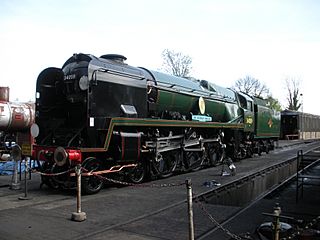 |
|
| Preserved Rebuilt Battle of Britain class No. 34059 Sir Archibald Sinclair. at Sheffield Park, Bluebell Railway | |
| Power type | Steam |
|---|---|
| Designer | R. G. Jarvis (after Oliver Bulleid) |
| Rebuilder | SR Brighton/Eastleigh Works |
| Rebuild date | 1955–1961 |
| Number rebuilt | 60 |
| Configuration | 4-6-2 (Pacific) |
| Gauge | 4 ft 8 1⁄2 in (1,435 mm) |
| Leading wheel diameter | 3 ft 1 in (0.940 m) |
| Driver diameter | 6 ft 2 in (1.880 m) |
| Trailing wheel diameter | 3 ft 7 in (1.092 m) |
| Length | 67 ft 4.75 in (20.54 m) |
| Locomotive weight | 91.16 long tons (92.6 t) |
| Fuel type | Coal |
| Fuel capacity | 5.00 long tons (5.1 t) |
| Water capacity | 5,200 imp gal (23,640 L; 6,240 US gal) |
| Boiler pressure | 250 psi (1.72 MPa) |
| Fire grate area | 38.25 sq ft (3.55 m2) |
| Cylinders | 3 |
| Cylinder size | 16.375 in × 24 in (416 mm × 610 mm) |
| Tractive effort | 27,720 lbf (123.3 kN) |
| Power class |
|
| Locale | Great Britain |
| Withdrawn | 1964–1967 |
| Disposition | 10 preserved, 50 scrapped |
Because of the problems with the original design, British Railways decided to rebuild sixty of these trains. They wanted a more traditional design. The first train to be rebuilt was No. 34005 Barnstaple in 1957.
The smooth casing was removed, and the boiler was covered in a more normal way. The boiler pressure was lowered. The chain-driven valve gear was replaced with a more common type called Walschaerts valve gear. This was fitted both outside and between the frames.
However, in the early 1960s, British Railways started to use more diesel and electric trains. This meant the remaining fifty trains were never rebuilt. They continued to run in their original condition until they were taken out of service.
How the Rebuilt Trains Performed
The rebuilding fixed most of the maintenance problems. Repair costs went down a lot, and they used less coal. However, the new valve gear made the rebuilt trains heavier. This meant they couldn't be used on some lines that the original, lighter trains could.
When They Were Retired
New electric lines meant these trains had less work to do. Also, some lines they used to run on were moved to a different railway region. This led to many of the unrebuilt trains being retired from 1963. By the end of that year, ten had been withdrawn, including the 12-year-old No. 34110 66 Squadron. Most of the unrebuilt trains were retired over the next three years.
Many rebuilt trains were also retired soon after being rebuilt. For example, No. 34028 Eddystone was retired in May 1964, even though it had only run a short distance since its rebuild.
| Year | Quantity in service at start of year |
Number withdrawn | Quantity withdrawn |
Locomotive numbers |
|---|---|---|---|---|
| 1963 | 110 | 10 | 10 | 34011/35/43/49/55/67-69/74, 34110 |
| 1964 | 100 | 29 | 39 | 34016/20/27-30/45/54/58/61-62/65/70/72-73/75/78/80-81/83/91-92/94/96/99, 34105-107/109 |
| 1965 | 71 | 16 | 55 | 34007/10/14/22/31/33/39/42/63/46/50-51/53/84-85, 34103 |
| 1966 | 55 | 18 | 73 | 34005/09/12/17/26/32/38/41/48/59/64/66/76/79/82/86/97, 34101 |
| 1967 | 37 | 37 | 110 | 34001-004/06/08/13/15/18-19/21/23-25/34/36-37/40/44/47/52/56-57/60/71/77/87-90/93/95/98, 34100/102/104/108 |
Preserved Locomotives
Twenty of these "Light Pacifics" still exist today! Two were saved directly from British Railways. The other eighteen were bought from Woodham Brothers' scrapyard in Barry, South Wales. Without this scrapyard, no rebuilt Light Pacifics would have been saved.
Ten of the preserved trains are in their original "unrebuilt" form, and ten are in their "rebuilt" form. Eleven are named after West Country places, and nine are named after RAF Squadrons or important people like Winston Churchill.
These trains are very useful for heritage railways because they are powerful and can run on many different tracks. Some have even returned to the main railway lines for special trips. It's not certain if all of them will be restored to working order, as some were in very bad condition when saved.
Many nameplates from these trains were also saved and are now in private collections.
| Number BR | Number SR | Name | Builder | BOB or WC | Type | Photograph | Current Location | Status |
|---|---|---|---|---|---|---|---|---|
| 34007 | 21C107 | Wadebridge | Brighton | West Country | Unrebuilt | Mid Hants Railway | Undergoing assessment for an overhaul to mainline standards | |
| 34010 | 21C110 | Sidmouth | Brighton | West Country | Rebuilt | Sellindge, Swanage Railway | Under restoration | |
| 34016 | 21C116 | Bodmin | Brighton | West Country | Rebuilt | West Coast Railways Carnforth | Under overhaul to main line standards | |
| 34023 | 21C123 | Blackmoor Vale | Brighton | West Country | Unrebuilt | Bluebell Railway | Awaiting overhaul | |
| 34027 | 21C127 | Taw Valley | Brighton | West Country | Rebuilt | Severn Valley Railway | Operational (fitted for air brakes but not mainline certified) | |
| 34028 | 21C128 | Eddystone | Brighton | West Country | Rebuilt | Swanage Railway | Operational | |
| 34039 | 21C139 | Boscastle | Brighton | West Country | Rebuilt | Great Central Railway | Undergoing overhaul | |
| 34046 | 21C146 | Braunton | Brighton | West Country | Rebuilt | Bridgnorth MPD, though normally Crewe Diesel TMD | Operational, main line certified | |
| 34051 | 21C151 | Winston Churchill | Brighton | Battle of Britain | Unrebuilt | National Railway Museum | Static display | |
| 34053 | 21C153 | Sir Keith Park | Brighton | Battle of Britain | Rebuilt | Herston Works, Swanage Railway | Under Overhaul | |
| 34058 | 21C158 | Sir Frederick Pile | Brighton | Battle of Britain | Rebuilt | Mid Hants Railway | Undergoing conservation to prepare her for a future restoration | |
| 34059 | 21C159 | Sir Archibald Sinclair | Brighton | Battle of Britain | Rebuilt | Bluebell Railway | Undergoing overhaul | |
| 34067 | 21C167 | Tangmere | Brighton | Battle of Britain | Unrebuilt | West Coast Railways Carnforth | Operational, main line certified. | |
| 34070 | 21C170 | Manston | Brighton | Battle of Britain | Unrebuilt | Swanage Railway | Operational | |
| 34072 | 257 Squadron | Brighton | Battle of Britain | Unrebuilt | Spa Valley Railway | Operational | ||
| 34073 | 249 Squadron | Brighton | Battle of Britain | Unrebuilt | West Coast Railways Carnforth | Stored, acting as a donor loco to 34067 | ||
| 34081 | 92 Squadron | Brighton | Battle of Britain | Unrebuilt | Nene Valley Railway | Operational | ||
| 34092 | City of Wells | Brighton | West Country | Unrebuilt | East Lancashire Railway | Withdrawn from service in 2023 for an overhaul. Fitted with Giesl ejector | ||
| 34101 | Hartland | Eastleigh | West Country | Rebuilt | North Yorkshire Moors Railway | Undergoing overhaul | ||
| 34105 | Swanage | Brighton | West Country | Unrebuilt | Mid Hants Railway | Undergoing overhaul |
Colours and Numbers
Southern Railway Style
When first built, these trains were painted a dark green color called "malachite green." They had bright "Sunshine yellow" lines. A round brass plate on the front showed the word "Southern" and the year it was made.
Bulleid used a special numbering system. For example, "21C" meant it had two small wheels at the front, three big driving wheels, and one small wheel at the back. The "1" after that meant it was the first series of this type of train.
British Railways Style
After 1948, when British Railways took over, the trains were still painted malachite green at first. But they soon changed to a darker green called "Brunswick green" with orange and black lines. The British Railways logo was on the side of the tender.
The original Bulleid numbers were changed. For example, 21C101 became 34001. The rebuilt trains also got the Brunswick green paint. Their nameplates were placed on a special mount because the smooth casing was gone.
Some trains had extra decorations. For example, No. 34050 Royal Observer Corps had a special medal design on its side.
How Well They Worked
People have different opinions about these trains, both the original and rebuilt versions. They were very advanced for their time. The way their boilers made steam was a big step forward in British train technology. They could also run very fast.
However, having so many new ideas at once made them hard to keep running. They were expensive to maintain. A lot of money was spent trying to fix their problems. Also, more "Light Pacifics" were built than were really needed. They often did jobs that a smaller, cheaper train could have done.
Even the expensive rebuilding program was questioned. Soon after, diesel and electric trains became more common. This meant the rebuilt steam trains didn't have a very long life in their new form.
Models of the Trains
If you like model trains, you can find models of these locomotives!
- Kitmaster made plastic kits for 00 gauge models from 1960. These kits are still made by Dapol today.
- Hornby Dublo made metal models of the "rebuilt" trains in the 1960s.
- Hornby now makes ready-to-run models of both the original and rebuilt versions.
- Graham Farish and Dapol make models for N gauge (a smaller size).
See also
- Southern Locomotives Ltd – a group that owns several of these preserved trains.



